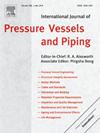某主蒸汽旁通管线承插焊缝穿壁失效及缺陷评定方法
IF 3
2区 工程技术
Q2 ENGINEERING, MECHANICAL
International Journal of Pressure Vessels and Piping
Pub Date : 2025-04-15
DOI:10.1016/j.ijpvp.2025.105531
引用次数: 0
摘要
近日,萨里核电站1英寸级2级汽轮机辅助给水蒸汽供应旁路发生穿壁泄漏事故。泄漏的原因被确定为一个非常小的缺陷,在一个套接焊缝附近的配件侧焊接趾。在受影响的承接焊缝中发现的焊缝缺陷基于退化截面方法进行评估,以证明这种情况的可接受性,这构成了向NRC寻求救济的基础,并允许根据ASME第XI节设计和安装结构夹具所需的时间,以确保焊接接头的长期稳定性。认识到内部方法的局限性,以及需要一种通用方法来解决与整个行业的插座焊接故障相关的类似事件,因此提出了一种基于线性弹性断裂力学的缺陷评估方法,类似于ASME第XI节代码案例N-513中使用的方法,并为插座焊接定义了新的应力术语。建立了旁路管线承插焊缝有限元模型,对其应力进行了详细的计算。为了研究焊缝几何形状对焊缝强度的影响,计算了从焊缝根部到焊缝表面最短距离处的半椭圆缺陷的应力强度因子。通过使用几何因素来解释几何对承插焊缝附近应力的影响,证明了这种方法是可行的。本文还讨论了所提出的承插焊缝缺陷评估方法的范围和适用性,以及为建立验收标准和计算应力强度因子所使用的参数提供基础所需的未来工作。本文章由计算机程序翻译,如有差异,请以英文原文为准。
Through-wall failure of a main steam bypass line socket weld and the flaw evaluation methodology
A recent event of through-wall leakage occurred on a 1 inch Class 2 turbine driven Auxiliary Feedwater steam supply bypass line at Surry Nuclear Power Station. The cause of the leakage was identified as a very small defect in a socket weld near the fitting side weld toe. The as-found weld flaw in the affected socket weld was evaluated based on a degraded cross-section methodology to demonstrate the acceptability of this condition, which formed the basis to seek relief from the NRC and allowed the time needed to design and install a structural clamp per ASME Section XI to ensure long-term stability of the welded joint. Recognizing the limitation of the in-house methodology and the need for a common methodology for resolutions to similar events associated with socket weld failures from across the industry, a flaw evaluation methodology based on Linear Elastic Fracture Mechanics, similar to the approach used in Code Case N-513 of ASME Section XI was proposed, along with new stress terms defined for socket welds. Finite Element models were developed for the bypass line socket weld to evaluate stresses in detail. Stress intensity factors were calculated for postulated semi-elliptical flaws along the shortest distance from the socket weld root to its surface, as an attempt to investigate the effects of the socket weld geometry on the weld strength. It is demonstrated that such an approach is feasible through the use of geometrical factors to account for the effects of the geometry on the stresses in the vicinity of the socket weld. The scope and applicability of the proposed flaw evaluation methodology for socket welds were also discussed, along with future work required to provide the bases for establishing the acceptance criteria and the parameters used in calculating the stress intensity factors.
求助全文
通过发布文献求助,成功后即可免费获取论文全文。
去求助
来源期刊
CiteScore
5.30
自引率
13.30%
发文量
208
审稿时长
17 months
期刊介绍:
Pressure vessel engineering technology is of importance in many branches of industry. This journal publishes the latest research results and related information on all its associated aspects, with particular emphasis on the structural integrity assessment, maintenance and life extension of pressurised process engineering plants.
The anticipated coverage of the International Journal of Pressure Vessels and Piping ranges from simple mass-produced pressure vessels to large custom-built vessels and tanks. Pressure vessels technology is a developing field, and contributions on the following topics will therefore be welcome:
• Pressure vessel engineering
• Structural integrity assessment
• Design methods
• Codes and standards
• Fabrication and welding
• Materials properties requirements
• Inspection and quality management
• Maintenance and life extension
• Ageing and environmental effects
• Life management
Of particular importance are papers covering aspects of significant practical application which could lead to major improvements in economy, reliability and useful life. While most accepted papers represent the results of original applied research, critical reviews of topical interest by world-leading experts will also appear from time to time.
International Journal of Pressure Vessels and Piping is indispensable reading for engineering professionals involved in the energy, petrochemicals, process plant, transport, aerospace and related industries; for manufacturers of pressure vessels and ancillary equipment; and for academics pursuing research in these areas.

 求助内容:
求助内容: 应助结果提醒方式:
应助结果提醒方式:


